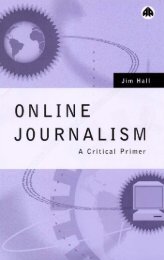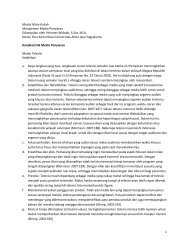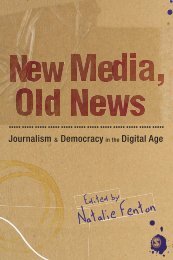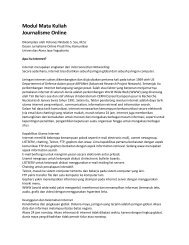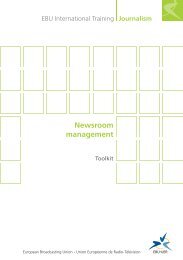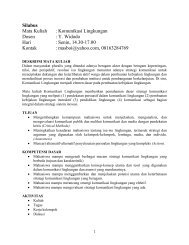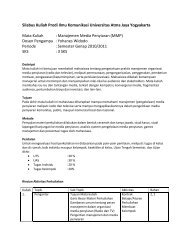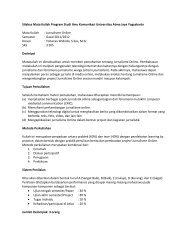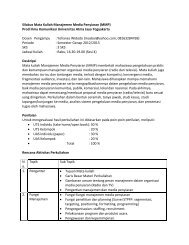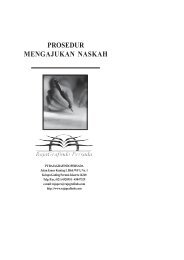1What is online journalism? - Ayo Menulis FISIP UAJY
1What is online journalism? - Ayo Menulis FISIP UAJY
1What is online journalism? - Ayo Menulis FISIP UAJY
You also want an ePaper? Increase the reach of your titles
YUMPU automatically turns print PDFs into web optimized ePapers that Google loves.
Online story construction 145<br />
The two-way model<br />
Th<strong>is</strong>, as it suggests, not only allows the journal<strong>is</strong>t to send<br />
something, but also allows something to come back from the user.<br />
Th<strong>is</strong> <strong>is</strong> the beginning of interaction. However, there can be two<br />
levels of interaction within the two-way model.<br />
At the first level, something <strong>is</strong> coming back from the user. It <strong>is</strong><br />
the choices the users make about what they want to see and<br />
hear based on the non-linear consumption model. They are<br />
taking control of what they consume, but they are still only<br />
consuming.<br />
At the second level, the user starts to contribute as well as<br />
consume. The interaction <strong>is</strong> still two way – between journal<strong>is</strong>t<br />
and user – but the user becomes the provider as well as the<br />
consumer. Most journal<strong>is</strong>ts, including those working on hard<br />
copy newspapers, have now embraced e-mail. Some provide<br />
their e-mail address at the end of by-lined articles. Th<strong>is</strong> <strong>is</strong><br />
because journal<strong>is</strong>ts are above all pragmat<strong>is</strong>ts and will embrace<br />
any new technology if they can see the benefit. It only takes a<br />
couple of journal<strong>is</strong>ts to mention the great lead they got on a<br />
story from a reader’s e-mail to have the rest clamouring at the<br />
news editor’s desk for the same opportunity. Feedback and<br />
story ideas from readers are a primary example of the second<br />
level of interaction within the two-way communication model.<br />
Bob Eggington has frequently seen those effects at first hand and<br />
believes that such interactivity <strong>is</strong> ‘changing the face of<br />
journal<strong>is</strong>m’:<br />
When something happens in any part of the world we found<br />
on BBC News that you could rely on people from the area<br />
concerned to get in touch with you almost immediately. The<br />
old way of operating in journal<strong>is</strong>m was that whenever<br />
anything happened, you struggled immediately to find<br />
witnesses, corroboration and contributions from people on<br />
the scene. You were hitting the phones and you were looking<br />
up telephone books for addresses and generally scrabbling




